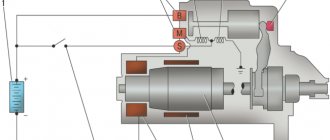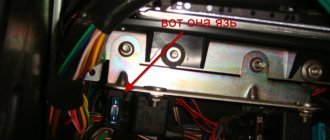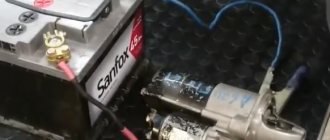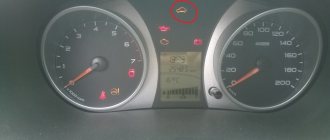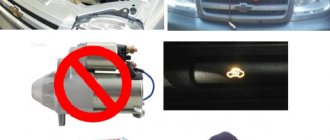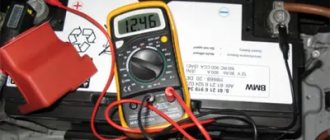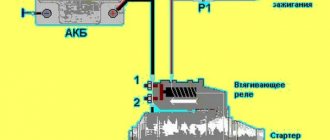Any car engine is started using a starter. The use of this electrical unit allows you to start the power plant without any effort on the part of the driver - simply turn the ignition key to the desired position.
Despite the fact that many brands of cars of different classes are produced, the design and principle of operation of the starter are identical (the only difference is in size and some design features). And this, in turn, affects malfunctions - they are all the same for any model.
One of the most common problems that many car enthusiasts face is the starter not working. That is, the driver turns the key, and in response hears only one or several clicks, but the mechanism itself does not start working.
Such problems can arise for several reasons, some of which can be easily eliminated, while others require serious repairs or replacement of the unit or its components.
Types and design of electric starter relay
There are three types of starter relay:
- blocking (preventing the device from starting when the engine is running);
- unloading (converting lower currents into stable 12 V);
- retractor (traction), which is attached directly to the starter.
The first two are certainly important, but they are not installed on every car, unlike the “traction” one, without which the engine will not start.
The traction electromechanical relay is responsible for:
- The bendix is thrown into engagement with the flywheel.
- Closing and holding the bridge between the “plus” of the relay and the starter.
- Stable power supply to the brush assembly of the electric starter.
- Timely shutdown of the trigger mechanism.
Starter solenoid relay diagram
Inside, it is arranged simply: under the metal body there is a two-winding coil with a core. On the one hand, the body has a protruding rod (the pulling end of the armature), on the other, an ebonite cover with three terminals (2 powerful contact bolts and one “pin”). The lower bolt is connected to the plus of the electric starter by a power wire (oblique). The armature - a metal core - “walks” longitudinally inside two windings (coils): “retracting” (VO) and “holding” (CU). When retracted, it presses on a movable electrode, at the end of which a spring-loaded copper contact plate is attached. At the end of the armature (core) stroke, the plate is pressed against the “nickels” of the bolts, closing a short circuit - from one to the other, and then to the electric starter brushes.
The edge of the core is connected to a fork lever that moves the Bendix gear forward. In the non-working position, it protrudes far from the body, and when current is supplied to the pulling coil, it goes under it, “pulling” the upper edge of the “fork” behind it. Swinging on the axis, its lower edge moves forward - carrying out, through the driving clutch, the Bendix (gear with a freewheel) into engagement with the teeth on the flywheel crown. When this happens, a metallic knocking or clicking sound is heard.
Unit repair
According to experts, the service life of the starter is up to 6 years. If this unit has been in regular use for several years and has stopped working, then it should be carefully checked. Regardless of the cause of the breakdown, the first thing that needs to be done is to conduct a visual inspection to identify visible problems.
You should carefully inspect the contacts, since often the starter stops working precisely because of them. An unstable charge can also cause the starter to fail to turn, so you need to try starting the car several times.
But even if the car starts, you should not assume that the breakdown resolved itself. Sooner or later the car will stop starting and the breakdown will need to be solved in a radical way. Simply replacing the starter may not always solve the problem.
To remove a part for subsequent disassembly you need:
- Disconnect the terminals and remove the battery.
- Remove the protective shield under the engine.
- Unscrew all nuts that secure the starter wires.
- Remove the bolts that connect the starter to the crankcase.
- Pull out the starter.
- Unscrew the nuts and remove the relay from the cover.
- Unscrew the bolts, remove the covers, and then remove the rotor.
Replacing bushings
To replace the bushings, you should increase the gap formed between the shaft and the support. The cause is often a misalignment that causes the rotor to touch the plate on the stator. The defect is solved by replacing the part.
- You need to knock out the front support and remove the rear bushing. This can be done with a special puller or by drilling.
- New parts must be installed using soft mandrels. Under no circumstances should you warp the products or use excessive force.
- Before installing the bushing, it is recommended to immerse it in engine oil for several minutes to saturate the porous material.
Replacing brushes
These elements supply voltage to the rotor, or rather its winding.
Instructions for replacing brushes:
- Remove the cover.
- Unscrew the 4 screws that secure the brushes.
- Replace the elements with new ones.
- Clear the cavity from recycling.
Relay repair
This unit is necessary for the gear to move along the rotor. The element is located on the body of the unit.
First, the control relay is checked. The screw securing the part should be tightened thoroughly to check for oxide on the wire and plates.
To test the relay you need to close the drive directly. The unit must be replaced with a new one if the rotor rotates.
If the unit is working properly, the resistance on the coils is 75 - 55 Ohms. If it does not meet these indicators, then they need to be changed, since they cannot be repaired.
Assembly and installation
To assemble the unit, you must perform the same steps, only in reverse order. Correctly install the cotter pins and corkscrew rings that are provided in the design of some elements. Check the node for functionality.
Working principle of VR
A constant plus is supplied from the battery to the upper power bolt of the “traction” bolt. In the free state, the contact plate does not touch the “nickels” of the power bolts in the cover. Both windings – the pull winding (VO) and the holding winding (CU), are connected with one terminal to a small “control” terminal, which receives the starting pulse from the ignition key (plus). The second output - a more powerful VO - goes to the jumper with the lower power bolt (plus of the starter electric motor), and the OU - to the “ground” (housing).
Starter connection diagram
As soon as the ignition key closes the power supply circuit to the VO, the current in it will create a magnetic field, under the influence of which the core will move inside the housing, push the bendix forward, and press the plate to the terminals. The plate will create a “short path” for high voltage current - from the top bolt, to the bottom and to the starter brushes. When the current flows through it, the “minus” disappears from the traction winding. Now only the holding one starts working, which is still energized (and will be as long as the ignition key remains in the “Start” position).
Connection diagram
The starter is controlled remotely from the vehicle's cabin. The connection diagram may differ, but the main elements of the circuit are the same.
The unit is equipped with a powerful electric motor (1). The negative terminal is the internal combustion engine. The positive wire from the battery is connected to the solenoid relay (6). When it is turned on, the contacts communicate the positive wire from the battery and the windings of the electric motor.
Voltage from the battery (2) is supplied to the coils of the solenoid relay from the ignition switch (3). To prevent the appearance of carbon deposits on the ignition switch contacts, modern cars are equipped with an intermediate relay (5), which supplies voltage to the retractor. Its control contact is connected to the ignition switch.
Why does the relay click but the starter does not turn the engine?
A single click “indicates” that the retractor winding is working, the bendix is “out.” If after this the gear does not turn, either the car starter itself is faulty, or the freewheel has failed. If the retractor often “shoots” with the bendix, it means that the problem is in the holding coil, which is unable to “pick up” the core when the pulling coil has already turned off.
In order for the car engine to start, the Bendix needs to spin with good force, while being in clear engagement with the teeth of the flywheel ring.
The force is fully provided by the electric starter motor, but the relay “opens the way” for it, so the stable operation of the devices is interconnected. If the starter clicks, the problem is definitely not in the retractor winding.
Possible breakdowns:
- The battery is dead or the terminals are not tightened.
- There is no stable “mass” for VO.
- Starter armature short circuit.
- Loss of conductivity on nickels.
- The brushes crumbled.
- The general “mass” (battery) has come off.
To quickly check one problem unit - with a screwdriver or a wrench - tap 2-3 times (shortly, sharply, but not hard) on the solenoid relay body, closer to the cover. Loss of conductivity often occurs from misalignment of the plate that closes the heels. This will force her to return to her place.
Car battery is faulty
One of the most common reasons that the starter starts to crackle and turns poorly is that the battery is insufficiently charged. Such symptoms appear when the main power source of the car is discharged or broken.
To make sure that the problem lies in the battery, you need to check how the engine starting system behaves. The following problems may occur:
- Lack of any response to ignition. There are no sounds, the starter does not click, does not show any signs of life. If such a problem is detected, then check the performance of the battery by turning on any electrical consumer - a tape recorder, lighting fixtures, etc.
- The instrument panel flashes and a crackling sound is heard from the solenoid relay. In such a case, as a rule, the battery is to blame.
- The starter clicks and sometimes the dashboard goes dark.
In the above cases, it is initially checked how charged the battery is. Use a load fork or a multimeter. In such a case, you just need to charge it.
When, after carrying out the manipulations, it was possible to find out that the battery is working, then it is necessary to start looking for other reasons for the starter’s failure to spin.
A malfunction in which the retractor has nothing to do with it
The situation when the starter turns, but the engagement between the teeth of the Bendix gear and the flywheel ring does not work, happens often. Especially after repairs with the replacement of the bendix, or in cars with over two hundred kilometers.
Worn bendix gear
Despite the fact that a click was heard, signaling that the bendix had come out, the length of its stroke was not enough for full contact, and the motor would spin the clutch idle. With this malfunction, you can hear the characteristic buzz of a working starter, vigorous, but ineffective. Neither from the second nor from the tenth start will it be possible to get rid of the problem - you need to remove the electric starter, check the pushing force of the “traction”, the condition of the teeth on the bendix and the starter ring of the flywheel.
Where do the clicks come from?
When trying to start the engine, the motorist hears sounds reminiscent of clicking. They are produced by a traction relay, consisting of 2 different windings - retracting and holding.
The first one retracts the relay core, but if the voltage is insufficient, it is released by the second winding.
With such movements, a peculiar clattering sound occurs, which the driver hears. Almost everyone says that it is the starter clicking, although a similar sound is made by the traction relay.
If you hold the key in the starting position longer in the ignition switch, the number of clicks will be greater, since the retracting winding will “tighten” the core several times, and the holding winding will release it.
Typical solenoid relay malfunctions and their symptoms
Open or short circuit in the control circuit. They can happen on any segment - from the ignition switch to the terminal on the VR housing. This category includes: wear of the contact group of the lock itself, a blown fuse, a closed locking relay, a short circuit in the wiring harnesses, oxidation of the terminals in the blocks. Failure manifests itself in different ways. More often - a complete lack of response from the device to startup attempts. Sometimes the starter only clicks at first until the battery runs out.
Burning of the contact group inside the device, due to which a large current does not flow to the brushes of the electric motor, and it does not rotate. Loss of conductivity due to carbon deposits, oxidation of the coins, a broken plate or a plate that has moved out of place is the second most common problem with the starter relay. With such malfunctions, the starter sometimes clicks, but does not turn the gear.
Burnt wires and oxidized contacts of the retractor relay
A break in the holding winding at the point where it is attached to the body - due to which, instead of one operation, a whole “cascade” of useless clicks is heard. Bendix does not have time to engage with the teeth of the flywheel - it is immediately thrown back. At the same time, the car gives a clear picture of short “idle” clutch activations with knocking, howling, crackling or buzzing. The case does not quite fit the definition: “the relay clicks, but the starter does not turn,” but refers purely to the breakdown of the solenoid relay.
VO short circuit - with this breakdown, the starter clicks, but cannot completely push out the bendix and supply power to the lower power bolt (to the brushes). The malfunction is detected only when removed from the car and the coils are checked one by one.
Popular brands:
Infiniti QX80
Bushings
These elements are located on both sides of the starter. Their task is to control the rotation of the shaft. If the bushings are too worn, then the starter will not start and will make clicking noises. Problems can arise if the starter is not installed correctly and is not in the right place. There could also be a short circuit in the winding.
Heavy cranking may indicate poor performance of the bushings, even if the power unit is warmed up.
The failure of the bushings is not a serious failure, but if you do not want to encounter a problem when the car refuses to start, then they need to be changed in time. Moreover, the bushings can cause the starter shaft to jam, which can lead to self-ignition.
How to check the solenoid relay
You can check the VR in two ways - without removing it from the car and after removing it together with the starter. If you suspect that the signal from the lock is lost somewhere in the circuit, first carry out a regular test on the car, then, based on the results, the unit can be removed and checked more accurately - with a multimeter.
Check without removing from the car:
- Put the car on the handbrake, make sure it is in neutral gear.
- Turn on the ignition and leave the key in the lock.
- Remove the connector (thin wire) from the control terminal BP.
- Using a screwdriver, close the terminal with the upper power bolt (plus from the battery).
If after this the car starts, the problem is in the control circuit (the pulse from the lock does not reach the terminal). If the starter continues to click but does not turn, check the devices separately. To do this, the “traction” needs to be disconnected from the starter housing (it’s easier to remove them from the car together, and then separate them).
Check after removal:
- Turn the multimeter into audible dialing mode.
- Connect one probe of the device to the control terminal.
- The second one has a lower power bolt (terminal for brushes).
- If there is a signal, the pull-in winding is intact.
- Leaving the first probe on the terminal, attach the second one to the body.
- If there is a signal, the holding coil is also intact.
- Install the device vertically, on the anchor, with the terminals facing up.
- Place the feeler gauges on the bolts - one on the top, one on the bottom.
- Press the relay, pressing the armature all the way.
- If there is sound, the power terminals are closed correctly, the plate is working.
- If there is no sound, but the display displays numbers, it does not work. The reason is external resistance.
Checking the solenoid relay with a multimeter
If at least one breakdown is detected, the part is replaced with a new one or a known good one. If both coils are intact, and the plate closes the “nickels” normally, all that remains is to test the force with which the spare part moves the armature plunger. To do this, first measure the free play of the plunger by inserting the relay into place in the housing until the loop tightly touches the fork lever, and use a ruler to measure the distance between the electric starter housing and the retractor itself. Pull out the part, push the plunger in until it touches the spring, now set the resulting distance on the plunger from the edge of the body. Mark (with marker or awl).
From the equipment you will need: a charged battery, three pieces of wire with a cross-section of 2 squares, with alligator clips and a plug for the control terminal (connector 50).
Strength check:
- Fix two wires with one end to the “ground” (body) of the part.
- Connect one of these wires to the negative terminal of the battery.
- Place the third wire with the plug on the positive battery.
- With one hand, press the part to the surface, “squeezing” the plunger to the mark.
- Place the plug on connector 50.
- Touch the end of the free wire (from the housing) to the lower power bolt.
- If the core overcomes the resistance and retracts, there is no problem, the retractor relay is working.
To evaluate the force, you need to securely fix the device (by the loop on the anchor) on a flat, solid base. The surface should not conduct current - for example, a wooden or cardboard-covered table.
Lack of contact in the starter circuit
Occurs as a result of metal corrosion or loosening of bolted wires. In addition, you need to check the grounding of the retractor and main relay of the starter assembly. You can check your car's electronics using a multimeter. Before doing this, inspect the wiring, tighten the bolts and check the terminals. If there is contact loss, restore their integrity.
Troubleshooting methods
If the check reveals a short circuit, it is easier to immediately replace the part with a new one. To restore normal conductivity on the “nickels” and correct a break in the holding winding at the fastening point, disassemble the spare part, desolder the terminals, clean the copper from oxide, reassemble, and tighten the fasteners.
Depending on the manufacturer and year of manufacture, the solenoid relay comes with a detachable housing (the cover of the power contacts is secured with screws) and with a one-piece housing (rolled into the metal of the housing). Diagnostics of both types of parts can be carried out without opening them, but there is a problem with repairs: with “one-piece” parts, the body is very difficult to assemble neatly and can easily be damaged during assembly. A cracked cover is unsuitable for further use. If you have little experience in fine work with electromechanical devices, it is easier to purchase a new, known working relay.
Bendix
This part is a more advanced analogue of the flywheel engagement unit, which begins to unwind after turning the ignition key. After the engine starts, the gear goes away. Bendix is also necessary for the normal operation of the solenoid relay.
If this unit is acting up, then when igniting it should make a loud crunching sound. In such a case, the starter should be dismantled, disassembled and checked:
- Turn the gear clockwise with your fingers. If the Bendix is working, then the gear should turn hard and be slightly spring-loaded.
- Now you need to scroll in the opposite direction. If the bendix is to blame, then you will succeed. If it is working, then the gear should remain in place even with serious force.
